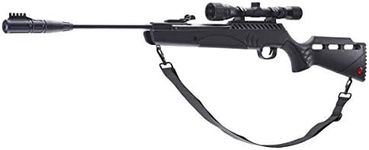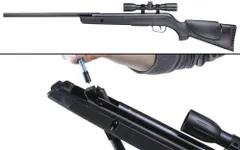Buying Guide for the Best Air Rifle For Adults
Choosing the right air rifle can be a rewarding experience, especially if you know what to look for. Whether you're interested in target shooting, hunting, or just plinking in the backyard, understanding the key specifications will help you make an informed decision. Here are the main factors to consider when selecting an air rifle for adults.CaliberCaliber refers to the diameter of the pellets that the air rifle shoots. The most common calibers are .177, .20, .22, and .25. The .177 caliber is popular for target shooting and small game hunting due to its high velocity and flat trajectory. The .22 caliber is preferred for hunting larger small game because it delivers more impact energy. The .25 caliber is less common but offers even more power for hunting. Choose a caliber based on your primary use: .177 for precision and target shooting, .22 or .25 for hunting.
Power SourceAir rifles can be powered by different mechanisms: spring-piston, gas piston, pre-charged pneumatic (PCP), and CO2. Spring-piston and gas piston rifles are popular for their simplicity and reliability, with gas pistons offering smoother cocking and shooting. PCP rifles provide high power and accuracy but require a separate air pump or tank. CO2 rifles are easy to use and offer semi-automatic firing but are less powerful and affected by temperature changes. Consider how you plan to use the rifle and your comfort with maintaining the power source.
VelocityVelocity, measured in feet per second (fps), indicates how fast the pellet travels when fired. Higher velocity means a flatter trajectory and potentially more accuracy at longer distances. For target shooting, a velocity of 600-800 fps is usually sufficient. For hunting, look for velocities of 800-1000 fps or higher to ensure enough power to humanely take down game. Match the velocity to your intended use, keeping in mind that higher velocity often comes with increased noise and recoil.
AccuracyAccuracy is crucial for both target shooting and hunting. Factors that affect accuracy include the quality of the barrel, the consistency of the power source, and the type of pellets used. Rifles with rifled barrels tend to be more accurate than those with smoothbore barrels. Consistent power sources like PCP and gas piston systems generally offer better accuracy. Additionally, using high-quality, well-matched pellets can significantly improve accuracy. Test different pellets to find the best match for your rifle.
Weight and ErgonomicsThe weight and ergonomics of an air rifle affect how comfortable it is to shoot, especially over extended periods. Heavier rifles can be more stable and absorb recoil better, but they can also be tiring to carry and aim. Lighter rifles are easier to handle but may be less stable. Consider the rifle's balance, the comfort of the stock, and the ease of use of the sights or scope. Choose a rifle that feels comfortable and manageable for your body size and strength.
Noise LevelThe noise level of an air rifle can be an important consideration, especially if you plan to shoot in a residential area or want to avoid spooking game. Spring-piston and gas piston rifles tend to be louder than PCP and CO2 rifles. Some air rifles come with built-in noise dampening features to reduce the sound. If noise is a concern, look for rifles advertised as 'quiet' or 'whisper' models, and consider the environment in which you'll be shooting.
Scope and SightsA good scope or set of sights can greatly enhance your shooting accuracy. Many air rifles come with iron sights, but adding a scope can help with precision, especially at longer distances. When choosing a scope, consider the magnification power and the quality of the optics. For target shooting, a scope with adjustable magnification can be beneficial. For hunting, a fixed-power scope might be more durable and easier to use. Ensure the scope is compatible with the rifle and securely mounted.




















